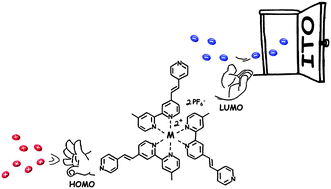Polypyridyl complexes as electron transporting materials for inverted bulk heterojunction solar cells: the metal center effect†
Abstract
The fundamental science behind the design of organic photovoltaic (OPV) cells lies in the formation of energy level gradients for efficient charge separation and collection. Tuning the energy levels at the device electrodes by the right choice of the components is a key requirement for achieving enhanced characteristics. Here we demonstrate control and optimization of OPV cell performance by using a set of polypyridyl complexes based on iron, ruthenium, and osmium centers with tunable frontier orbital energies as interlayers for inverted bulk heterojunction solar cells. We found that changing the metal center of isostructural transition-metal complexes results in evident shifts of the HOMO and LUMO energy levels and the work functions of the corresponding interlayers, which has a prominent effect on the device performance. We generalize our approach by combining the interlayers with different sets of photoactive materials to test the electron transporting as well as the hole blocking characteristics of the interlayers.


 Please wait while we load your content...
Please wait while we load your content...